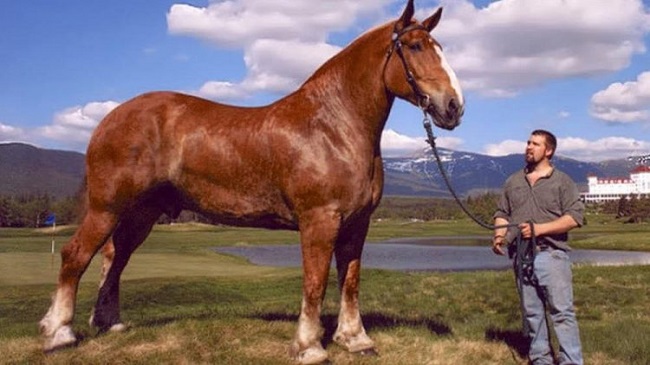Horses have long been revered for their grace, strength, and beauty. Among the equine kingdom, there are several breeds that stand out for their impressive size and commanding presence. Largest horses, renowned for their majestic stature, hold a special place among these magnificent giants.
In this comprehensive guide, we will delve into the world of the 11 largest horse breeds, including the awe-inspiring Largest Horses. We will explore their history, characteristics, and the traits that make them truly extraordinary.

11 Largest Hige Horse Breeds
Here are 11 largest hige horse breeds:
Read Also:
1. The Belgian Draft Horse
The Belgian Draft Horse, originating from Belgium, is one of the largest horse breeds in the world. With a robust build and gentle nature, these horses have been used for agricultural work, pulling heavy loads, and as reliable companions.
2. The Clydesdale
Clydesdales, known for their striking appearance and feathered legs, hail from Scotland. These powerful and versatile horses have made their mark in various fields, including agriculture, logging, and as iconic symbols for famous breweries.
3. The Shire Horse
Shire Horses, with their immense size and elegant appearance, are native to England. Once the backbone of agriculture, these gentle giants are now treasured for their presence in parades, shows, and as carriage horses.
4. The Percheron
Originating from France, the Percheron is a breed known for its strength and versatility. These horses have been used in agriculture, as carriage horses, and even in military operations due to their endurance and willingness to work.
5. The Suffolk Punch
The Suffolk Punch, England’s oldest breed of heavy horse, is characterized by its solid build, deep chestnut color, and gentle temperament. These horses were primarily used in agriculture and have a rich history tied to the Suffolk region.
6. The American Cream Draft
As the only draft breed developed in the United States, the American Cream Draft stands out for its distinctive cream-colored coat and impressive size. These horses are known for their versatility, strength, and calm disposition.
7. The Friesian
The Friesian breed, originating from the Netherlands, is renowned for its striking black coat, long flowing mane, and feathered legs. While not as large as some draft breeds, the Friesian’s noble appearance and elegance make it a favorite among equestrian enthusiasts.
8. The Drum Horse
The Drum Horse, a relatively new breed, is a combination of Clydesdales, Shires, and Gypsy Cobs. These horses are prized for their size, strength, and eye-catching appearance. They are often seen in parades and ceremonial events.
9. The Gypsy Vanner
Originally bred by the Romani people of the British Isles, the Gypsy Vanner is known for its compact build, abundant feathering, and kind temperament. These horses excel in various disciplines and have gained popularity for their versatility.
10. The Haflinger
The Haflinger, a breed hailing from Austria and Italy, may be smaller in stature compared to other breeds on this list, but its strength and endurance are remarkable. These horses are known for their golden coat, gentle nature, and versatility in both work and leisure activities.
11. The Highge Horse
The Highge Horse, a mythical breed, has captured the imagination of many horse lovers. Known for its towering size, graceful movement, and ethereal beauty, the Highge Horse embodies the epitome of equine grandeur. While not an actual breed, the concept of the Highge Horse continues to inspire artists and equestrians alike.
Read Also:
Conclusion
The 11 largest horse breeds, including the magnificent Highge Horse, showcase the awe-inspiring power, beauty, and versatility found within the equine world.
From the gentle giants like the Belgian Draft and Clydesdale to the regal Friesians and Gypsy Vanners, these horses leave an indelible impression wherever they go.
Whether used for work, leisure, or as cherished companions, these majestic breeds embody the captivating spirit of the equine world, making them beloved by equestrian enthusiasts around the globe.
























